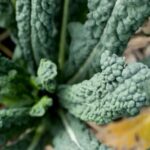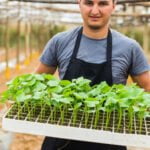Are you an urban dweller or someone with limited outdoor space? Small space vegetable gardening may be the perfect solution for you. This article will explore the benefits of small space vegetable gardening and provide valuable tips and advice for getting started. Whether you have a balcony, patio, or small backyard, you can still enjoy the satisfaction of growing your own fresh produce.
With the increasing trend of urbanization and limited outdoor spaces, small space vegetable gardening has become a popular choice for individuals looking to grow their own food. Not only does it provide an opportunity to enjoy fresh, homegrown produce, but it also promotes sustainability and self-sufficiency. Additionally, small space gardening allows individuals to connect with nature and enjoy the therapeutic benefits of gardening right in their own homes.
In this article, we’ll delve into planning and design tips for maximizing the use of limited space, including vertical gardening, container gardening, and utilizing small beds or raised beds. We’ll also discuss choosing the right vegetables for small spaces, soil selection, proper watering techniques, maintenance tips, harvesting advice, as well as real-life success stories of urban gardeners who have thrived with small space vegetable gardens.
So let’s get started on your journey to a thriving small space vegetable garden.
Planning and Design
When it comes to small space vegetable gardening, planning and design are crucial elements for maximizing the use of limited space. One popular method for maximizing space in small gardens is vertical gardening. This technique involves growing plants on a structure or trellis, allowing for more growing area without taking up a lot of ground space. Some vegetables that thrive in vertical gardens include tomatoes, cucumbers, and peas.
Another approach to small space vegetable gardening is container gardening. This method is ideal for those with limited outdoor space, as it allows you to grow a variety of vegetables in pots, hanging baskets, or other containers. Compact or dwarf varieties of vegetables are well-suited to this type of gardening and can thrive in small spaces such as balconies or patios. Examples of vegetables that do well in containers include lettuce, peppers, and herbs.
For those with a bit more room to work with, utilizing small beds or raised beds can be an effective way to maximize space while also providing good soil drainage and aeration. Raised beds are also easier to manage and maintain than traditional garden plots. When creating raised beds for small space vegetable gardening, it is important to ensure that the soil is well-draining and rich in organic matter.
In summary, regardless of limited outdoor space available for planting a vegetable garden at home or apartment living might seem daunting; however; by implementing vertical gardening methods like trellises & bamboo stakes installation as well using ingenious container systems; selecting the right compact crop species & establishing manufactured raised bed structures – anyone has the possibility to grow fresh produce sustainably nearby their homes. With these small-space vegetable gardening ideas being implied the impossible becomes possible.
Choosing the Right Vegetables
When it comes to small space vegetable gardening, choosing the right vegetables is crucial for a successful harvest. Fortunately, there are many compact or dwarf varieties that are perfect for those with limited outdoor space. Additionally, some vegetables thrive in containers, making them ideal for urban dwellers or anyone working with a small garden area.
Here are some great options for vegetables that are well-suited for small space gardening:
- Tomatoes: Look for determinate or dwarf tomato varieties that can be easily grown in containers or small beds.
- Peppers: Compact pepper plants are perfect for small gardens and can be grown successfully in pots or raised beds.
- Lettuce: Leafy greens like lettuce are great for small spaces and can even be grown indoors with the right lighting.
- Radishes: These fast-growing veggies are perfect for small containers and can quickly produce a bountiful harvest.
- Herbs: Culinary herbs like basil, cilantro, and parsley thrive in pots and can add flavor to your meals without taking up much space.
In addition to these options, there are many other vegetables that can thrive in a small space garden. When planning your vegetable selection, consider the available sunlight, climate, and growing conditions in your area. With careful consideration and the right care, you can enjoy a successful harvest from your small space vegetable garden.
It’s important to remember that while some vegetables may be better suited for a smaller garden area, others may require more room to spread out. Be sure to do your research on each individual vegetable variety before planting to ensure they will thrive in your small space. With the right choices and proper care, you can have a bountiful harvest from even the smallest of gardens.
Soil and Fertilizer
Small space vegetable gardening can be a rewarding and efficient way to grow your own produce, even with limited outdoor space. When it comes to ensuring the success of your small space garden, selecting the right soil and fertilizer is crucial. In a confined area, the soil is even more important because it’s serving as the sole source of nutrients for your plants.
For small space vegetable gardening, you’ll want to use rich, well-draining soil that’s high in organic matter. This type of soil will provide essential nutrients to your plants and promote healthy root growth. Additionally, consider using compost in your small space garden. Compost is an organic matter that provides a natural fertilizer for your plants and helps improve the overall structure of the soil.
Another option for small space vegetable gardening is using raised beds or containers filled with a high-quality potting mix specifically designed for vegetables. A good potting mix will offer excellent drainage while still retaining moisture, and it will be formulated with the right balance of nutrients to support healthy plant growth.
Here are some key considerations when selecting soil and fertilizers for small space vegetable gardening:
- Soil composition: Look for well-draining soil with plenty of organic matter
- Compost: Consider incorporating compost into your garden for natural fertilization
- Potting mix: For container gardening or raised beds, choose a high-quality potting mix designed for vegetables
| Product | Features |
|---|---|
| Jobe’s Organics Compost Starter | Organic materials feed microbes in the soil to improve soil health |
| Miracle-Gro Performance Organics All Purpose Container Mix | Formulated with aged compost and provides an ideal environment for growing vegetables in containers or raised beds |
Watering and Maintenance
When it comes to small space vegetable gardening, proper watering and maintenance are essential for the success of your garden. In a confined area, it’s especially important to utilize the right watering techniques to ensure that your plants receive the moisture they need without overwatering. Additionally, managing pests and diseases in a small space can be a bit more challenging, but with the right tips and strategies, you can keep your garden healthy and thriving.
Proper Watering Techniques
For small space vegetable gardening, efficient watering techniques are key. One of the most effective methods is drip irrigation, which delivers water directly to the roots of your plants. This conserves water and ensures that your plants get the moisture they need without wasting any resources. Another option is using self-watering containers for your garden, which can help maintain consistent moisture levels in a limited space.
Managing Pests and Diseases
In a small space garden, pests and diseases can spread quickly, so it’s important to stay vigilant. One strategy is companion planting, where you plant certain vegetables together to naturally repel pests or attract beneficial insects. Additionally, regularly inspecting your plants for signs of pests or disease can help you address issues before they become widespread. Organic pest control methods such as neem oil or insecticidal soap can also be used effectively in a small space environment.
Integrated Pest Management
Integrated Pest Management (IPM) is an approach that combines different strategies for controlling pests while minimizing environmental impact. For small space vegetable gardening, this may include using physical barriers like row covers or netting to protect plants from pests, as well as employing biological controls like introducing predatory insects or natural predators to manage pest populations. By utilizing a combination of these methods, you can effectively manage pests and diseases in your small space garden without resorting to harsh chemicals.
By incorporating these proper watering techniques and effective pest management strategies into your small space vegetable gardening routine, you can maintain a healthy and productive garden despite limited outdoor space.
Harvesting and Storage
When it comes to small space vegetable gardening, knowing when and how to harvest your crops is essential for a successful and bountiful harvest. Whether you are growing vegetables in containers on a balcony or utilizing a small raised bed in your backyard, understanding the signs of readiness for different types of vegetables is crucial. In a small space, it’s important to maximize the yield from each plant, making the timing of harvesting even more critical.
One of the keys to successful harvesting in small space vegetable gardening is paying attention to the specific characteristics of each type of vegetable. For example, tomatoes should be harvested when they are fully colored but still firm to the touch, while leafy greens such as lettuce and spinach are best when picked young and tender. Understanding these individual guidelines will help you make the most of your limited space and resources.
In addition to knowing when to harvest, proper storage and preservation methods are also crucial for small space vegetable gardening. After all your hard work, you’ll want to enjoy the fruits of your labor for as long as possible. Depending on the type of vegetable, proper storage may include refrigeration, canning, freezing, or drying.
Learning these techniques will help ensure that nothing goes to waste and that you can enjoy your homegrown produce throughout the year. By incorporating these tips into your small space vegetable gardening efforts, you can ensure a successful harvest and make the most out of your limited space.
Success Stories
Urban Gardening Challenges and Solutions
Many urban dwellers face challenges when it comes to finding space for vegetable gardening. However, with some creativity and resourcefulness, it is possible to grow a bountiful harvest in a small space. One successful urban gardener, Sarah Johnson, transformed her small city balcony into a thriving vegetable garden by utilizing vertical gardening techniques. She installed hanging planters and trellises to maximize her limited space, growing tomatoes, peppers, and herbs successfully.
Another challenge for small space vegetable gardening is adequate sunlight. In an interview with urban gardener Alex Nguyen, he shared his experience of using reflective materials to redirect sunlight to his balcony garden, allowing his vegetables to receive the necessary light despite being surrounded by tall buildings.
Community Garden Projects
In many cities, community garden projects have become popular among urban residents who lack their own outdoor space for gardening. These communal spaces allow individuals to rent or share small plots of land where they can grow their own vegetables. By joining forces with neighbors and fellow gardening enthusiasts, lot size has never been an issue. Some are now growing produce that was once only grown in large backyard soil.
In an interview with neighborhood volunteer coordinator Matt Cooper, he mentioned the positive impact of community garden projects not just on food production but also on community bonding. He emphasized how these projects have encouraged individuals to learn from one another’s experiences and have inspired more people within the community to start their own small space vegetable gardens at home.
Resources and Tools
In conclusion, small space vegetable gardening offers a multitude of benefits for urban dwellers or those with limited outdoor space. By maximizing the use of vertical gardening, container gardening, and small beds or raised beds, individuals can make the most of their space and still enjoy a bountiful harvest. Choosing the right vegetables, such as compact or dwarf varieties that thrive in containers, is essential for successful small space gardening.
When it comes to soil and fertilizer, selecting the right options for small space vegetable gardening is crucial. Organic options and composting can help nourish the soil and provide the necessary nutrients for healthy plants. Proper watering techniques and pest management are also important factors to consider in maintaining a thriving small space garden.
Knowing when and how to harvest vegetables in a small space garden, as well as tips on storing and preserving the harvest, will ensure that your hard work pays off. Additionally, seeking out resources such as tools, books, websites, and other supplies tailored specifically for small space vegetable gardening can provide valuable guidance and support for your gardening endeavors.
In closing, while small space vegetable gardening may present its challenges, it also offers ample rewards. By implementing the tips and techniques outlined in this article, individuals can transform their limited outdoor areas into flourishing gardens capable of producing an abundance of fresh produce. Whether you’re new to gardening or looking to enhance your existing skills, there are plenty of resources available to help you succeed in your small space vegetable gardening journey.

If you’re looking to get into vegetable gardening, or are just looking for some tips on how to make your current garden better, then you’ve come to the right place! My name is Ethel and I have been gardening for years. In this blog, I’m going to share with you some of my best tips on how to create a successful vegetable garden.





